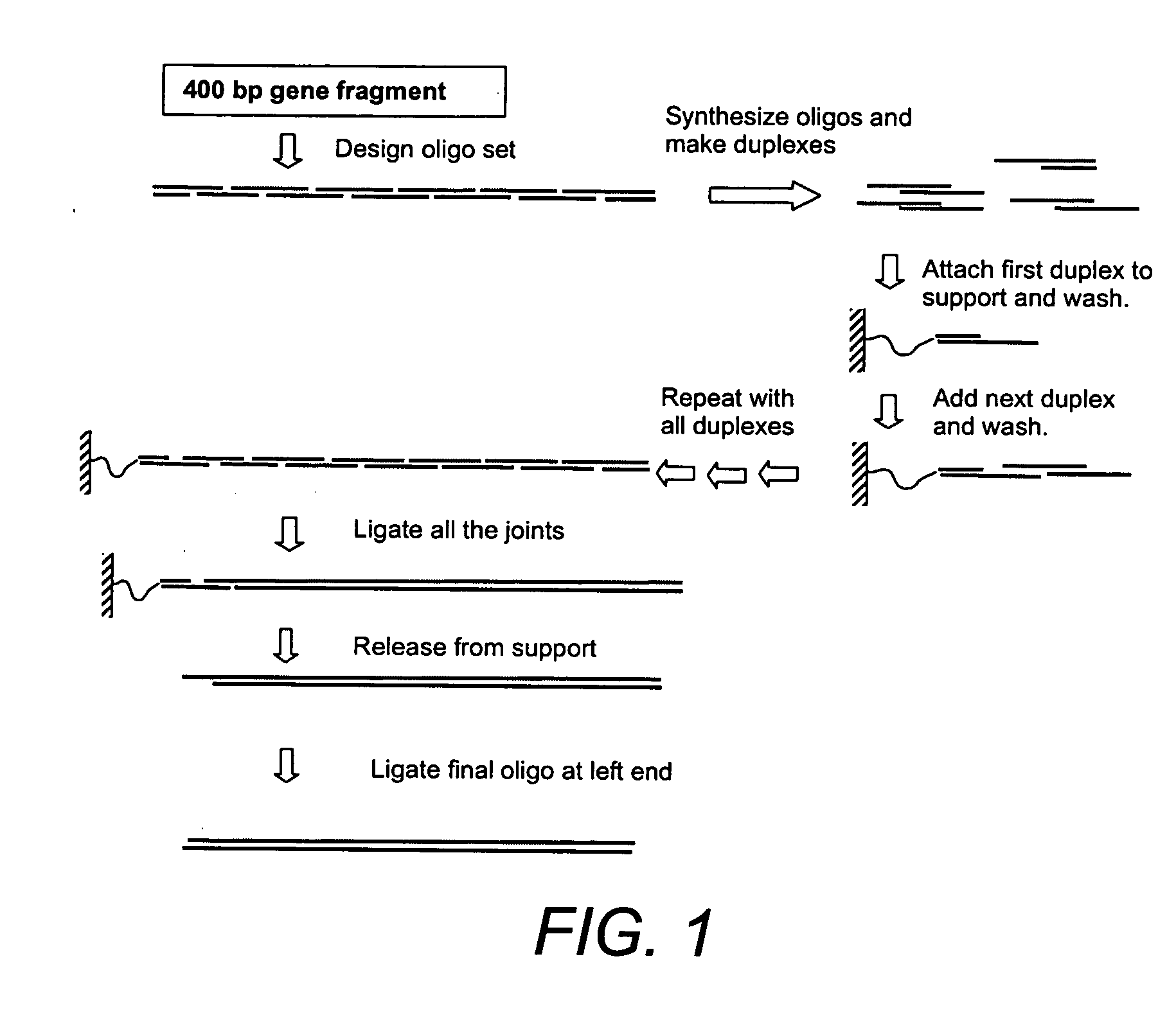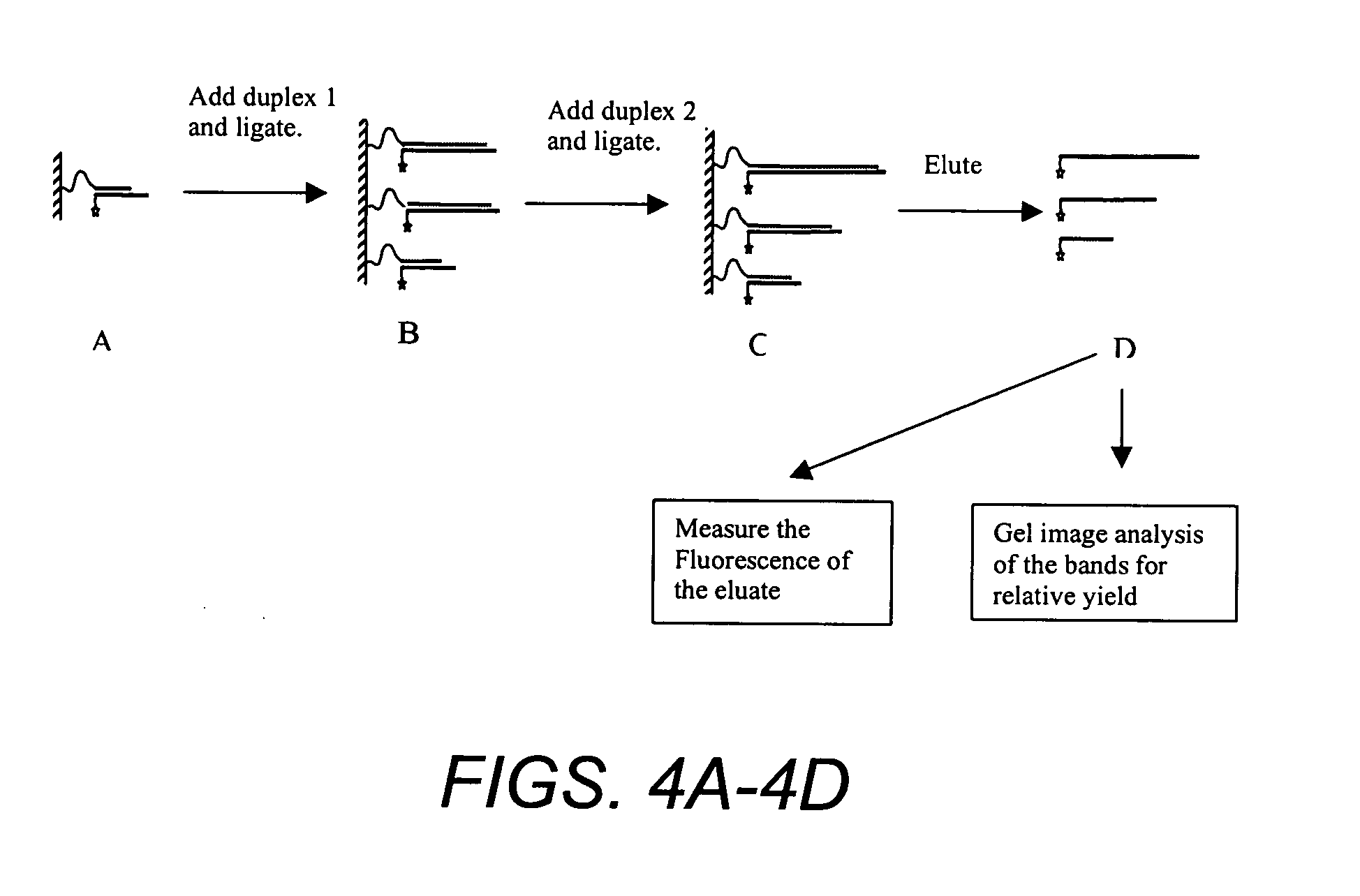Solid phase methods for polynucleotide production
a solid phase and polynucleotide technology, applied in the field of solid phase synthesis of polynucleotides, can solve the problems of time and effort required to prepare genes of a desired base sequence, inability to work on more than a fraction of the genes that have been identified, and inability to precisely the desired base sequence, etc., to achieve the effect of simplifying the reaction, and improving the efficiency of synthesis
- Summary
- Abstract
- Description
- Claims
- Application Information
AI Technical Summary
Benefits of technology
Problems solved by technology
Method used
Image
Examples
example 1
Building a 310-Base Pair Gene on a Particulate Solid Support
Acid-Treatment of Resin
[0261] Aminomethylated polystyrene resin (3 grams, ˜100 micron in diameter, Aldrich) was mixed with 4 ml of concentrated hydrochloric acid (HCI) and 12 ml of water in a glass scintillation vial. The resin was stirred in the acidic solution at room temperature for 1.5 hr. The acid-treated resin was washed with water until the pH of the filtrate reached 5-6. This procedure was repeated on a second batch of amionmethylated polystyrene resin using acetic acid in place of concentrated HCl, and dimethylformamide (DMF) in place of water, as the acid-treating conditions. The batches of acid-treated aminomethylated polystyrene resin were stored as wet solids at 4° C.
[0262] The two washed, acid-treated resins were qualitatively tested for surface amine content using tri-nitrobenzene sulfonic acid (TNBSA). Untreated resin was tested in the same manner, to provide a control experiment. The results are shown ...
example 2
Building a 240-Base Pair Gene on a Porous Polyethylene Support
Couple Linker Oligo to Polyethylene Frits by Carbodiimide.
[0285] Polyethylene frits of 9 mm diameter and 1.5 mm thickness with 7 and 20 micron pore size were purchased from Orochem Technologies (Westmont, Ill., USA; @orochem.com). Primary amine groups were introduced onto the surface of the PE frits by a plasma process performed by 4th State Inc. (Belmont, Calif., USA; @4thstate.com). All subsequent reactions and processes involving frits were carried out in a polypropylene cartridge as depicted in FIG. 12G (also purchased from Orochem Technologies). The frit is held in place by friction with the walls of the container.
[0286] Reagent and buffers are delivered to the frit from the top of the cartridge, mixed through the pores of the frit by a syringe pumping the liquid up and down through the frit, and removed from the frit by an empty syringe. The bottom opening of the cartridge is plugged during the reaction. Before...
example 3
Comparing Solid Phase Gene Assembly on Solid Support With and Without PEG Spacer
[0297] Separate batches of aminomethylated polystyrene resin were coupled to two different linker oligos. One linker oligo contained a PEG spacer (n=24) between the terminal amine group and the oligonucleotide (17b oligonucleotide EG(n=24)NH2). The other linker oligo did not contain any spacer and had carboxylic acid termination (17b oligonucleotide-COOH) where both oligos were obtained from Trilink. The oligo with PEG spacer was coupled to the polystyrene support using the coupling method described in Example 1. The linker oligo without a spacer was coupled to a different batch of the same polystyrene support and also to polyethylene frits using the carbodiimide method described next.
[0298] Before coupling, 150 ul packed volume of polystyrene resin was washed with 1 ml 0.1 M pH 4.5 morpholinepropane sulfonic acid (MOPS) twice. The coupling reaction was carried out with 3 μl carboxy function containin...
PUM
| Property | Measurement | Unit |
|---|---|---|
| Temperature | aaaaa | aaaaa |
| Force | aaaaa | aaaaa |
| Transport properties | aaaaa | aaaaa |
Abstract
Description
Claims
Application Information
 Login to View More
Login to View More - R&D
- Intellectual Property
- Life Sciences
- Materials
- Tech Scout
- Unparalleled Data Quality
- Higher Quality Content
- 60% Fewer Hallucinations
Browse by: Latest US Patents, China's latest patents, Technical Efficacy Thesaurus, Application Domain, Technology Topic, Popular Technical Reports.
© 2025 PatSnap. All rights reserved.Legal|Privacy policy|Modern Slavery Act Transparency Statement|Sitemap|About US| Contact US: help@patsnap.com



